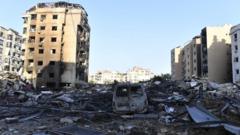Recent satellite imagery indicates that Israeli bombing in Lebanon has caused unprecedented damage, particularly in southern areas such as Dahieh, amid ongoing conflict with Hezbollah. Reports show that around 3,600 buildings have been impacted within two weeks, raising concerns about humanitarian repercussions as Lebanon faces significant internal displacement and civilian casualties.
Intensity of Israeli Bombing in Lebanon Revealed by Satellite Imagery

Intensity of Israeli Bombing in Lebanon Revealed by Satellite Imagery
Satellite and radar data shows extensive structural damage in Lebanon from Israeli strikes, with considerable implications for civilians.
The ongoing conflict between Israel and Hezbollah has led to significant destruction across Lebanon, with satellite imagery revealing a dramatic escalation in bombings. Data analyzed by organizations such as the BBC identifies over 3,600 buildings damaged or destroyed in a two-week period from October 2 to October 14, 2024, marking an increase in damage compared to the previous year of hostilities between the two sides.
Experts including Corey Scher from the City University of New York and Jamon Van Den Hoek from Oregon State University led the analysis of this satellite data, which indicated a staggering 54% of all estimated damage since the commencement of cross-border conflicts last year, has occurred during this recent escalation. Environmental analyst Wim Zwijnenburg from Pax for Peace characterized Israel's campaign as creating a “dead zone” in southern Lebanon to displace civilians and hinder Hezbollah’s military capabilities.
Tensions flared recently after Hezbollah began launching rockets into northern Israel in solidarity with Palestinians following Hamas's attack on southern Israel on October 7, 2023. Israel's subsequent airstrikes, notably deemed “limited and localized,” have targeted various areas, including the southern suburbs of Beirut such as Dahieh, alleged to be a Hezbollah stronghold.
Military records corroborate the assertion of at least 2,700 individual Israeli strikes in Lebanon from September 1 to October 11, while Hezbollah has retaliated with around 540 attacks against Israel in the same timeframe. The Israeli military claims its aims are to dismantle Hezbollah's infrastructure to ensure the safety of residents in Israeli border regions.
The scale of displacement in Lebanon has reached alarming levels, with the government reporting internally displaced persons numbering up to 1.3 million. The humanitarian crisis is underscored by severe shortages of shelter and essential resources, as expressed by Gabriel Karlsson of the British Red Cross in Beirut. The effects of these bombings have been catastrophic, leading to rising civilian casualties, with at least 2,350 reported deaths and over 10,000 injuries as a result of Israeli attacks, according to Lebanese health officials.
In Israel, around 60 fatalities and more than 570 injuries have been reported due to Hezbollah’s strikes, with the Israeli military asserting that collateral damage is an unfortunate but inevitable aspect of warfare, while suggesting that Hezbollah holds responsibility for instigating the conflict.
Experts such as Zwijnenburg caution about the repercussions of military actions on civilian infrastructure, citing extensive damage to vital services, which further exacerbates the humanitarian plight. Consequently, the escalating violence continues to generate intense scrutiny over the human costs of this protracted battle between Israel and Hezbollah, as both sides prepare for an uncertain future in a deeply affected region.





















